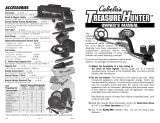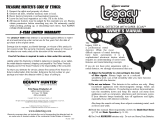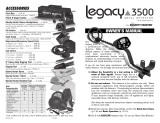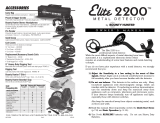
User’s Manual
To get the most from your HandyMan™ Metal Detector, we suggest you do the
following:
1. Use 9-volt ALKALINE batteries only.
• Do not use Heavy Duty batteries.
• Do not use ordinary Zinc-Carbon Batteries.
2. Make sure the right knob is clicked on (i.e. not in battery-test
position).
3. Note the following:
• Large metal objects inside the home may interfere with the
detector’s operation. Floors and walls of most homes contain
metal.
• Electrical appliances inside the home, like microwave ovens,
televisions, and some light fixtures, emit electromagnetic
energy which can interfere with the detector’s operation.
First Texas Products, LLC
1465-H Henry Brennan
El Paso, TX 79936
(915) 633-8354
MHM Rev.2 091212
The HandyMan™ is warranted against defects in
workmanship or materials under normal use for one year
from date of purchase to the original user. Liability in all
events is limited to the purchase price paid. Liability
under this Warranty is limited to replacing or repairing,
at our option, any HandyMan™ returned, shipping cost
prepaid, to First Texas Products, LLC. Damage due to
neglect, accidental damage or misuse of this product is
not covered by this warranty.
Copyright© 2012 by First Texas Products, L.L.C.
All rights reserved, including the right to reproduce this book, or parts thereof, in any form.
Published by First Texas Products, L.L.C.
HandyMan is a trademark of First Texas Products, L.L.C.
Proof of purchase is required to make a claim under this warranty.
NOTE TO CUSTOMERS OUTSIDE THE U.S.A.
This warranty may vary in other countries, check with your distributor for details.
Factory warranty follows the channel of distribution.
Warranty does not cover shipping costs.
TREASURE HUNTER’S CODE OF ETHICS:
• Always check Federal, State, County and local laws before searching.
• Respect private property and do not enter private property without the owner’s permission.
• Take care to refill all holes and leave no damage.
• Remove and dispose of any and all trash and litter found.
• Appreciate and protect our inheritance of natural resources, wildlife and private property.
• Act as an ambassador for the hobby, use thoughtfulness, consideration and courtesy at all
times.
• Never destroy historical or archaeological treasures.
• All treasure hunters may be judged by the example you set; always conduct yourself with
courtesy and consideration of others

2
Installing Batteries
Use 9-volt ALKALINE batteries only!
1. Remove the battery door from the underside of the detector.
2. Pull out the two battery connectors.
3. Snap on two 9-volt ALKALINE batteries.
Do not use Heavy Duty or ordinary Zinc Carbon batteries.
4. Place batteries into compartment one on top of the other.
5. Replace the battery door.
Slide over until it shuts securely in place.
All battery brands differ slightly in size.
If you want to secure the batteries more tightly in the
compartment, feed the battery wires underneath and between the
batteries.
If batteries fit too tightly, causing battery door to bulge, move
battery wires toward front of compartment, not between the
batteries.
push door
from side
7
Operation
Sweep the search coil from side to side, in slow, overlapping motions.
Keep the search coil parallel to the ground.
Keep search coil 1/2” off the ground and try not to make contact with the ground.
Try not to lift the search coil at the end of your sweeps. This may be difficult
for younger children, but the closer the search coil is to the ground throughout
the sweep, the more likely you are to find buried metal objects.
Keep the left knob in the maximum sensitivity setting possible.
Click the right knob on and start searching with it in the fully counterclockwise position.
You may want to move the right knob during your search, depending on what
you find. For instance, if you start searching with the right knob to the left(but
not in battery test mode), you will detect all types of metal objects. If you find
that you are in a trashy area, and wish to eliminate unwanted objects from
detection, sweep the search coil over an undesirable object while turning the
knob. Find the knob setting at which certain types of metals are eliminated, and
adjust your settings accordingly.
CAUTION: Gold rings can be eliminated from detection along with pull-tabs.
Be aware that some desirable objects, like nickels and gold, are
eliminated from detection in the middle of the range. Gold rings have a
metallic signature similar to pull-tabs; nickels have a metallic signature
similar to some newer pull tabs. It requires practice and patience to
understand what types of objects are eliminated at each setting.
Pinpointing
Accurate pinpointing takes practice and is best accomplished by “X-ing” the
suspected target area.
1. Once a buried target is identified by a good tone response, continue
sweeping the coil over the target in a narrowing side to side pattern.
2. Take visual note of the place on the ground where the “beep” occurs
as you move the coil slowly from side to side.
3. Stop the coil directly over this spot on the ground.
4. Now move the coil straight forward and straight back towards you a
couple of times.
5. Again make visual note of the spot on the ground at which the “beep”
occurs.
6. If needed, “X” the target at different angles to “zero in” on the exact
spot on the ground at which the “beep” occurs.
REMEMBER: The HandyMan will beep just as the search coil passes over
the buried object.
If you have difficulty pinpointing very strong signals, try lifting the coil higher
off the ground until a weaker, but more concise, signal is heard. For very
weak signals, try moving the coil in short quick sweeps, closer to the ground.

6
Sensitivity & Target Elimination
Adjusting Sensitivity
The left knob clicks on to power the detector on.
After turning on, the left knob is used to control the detector’s sensitivity level.
In the 100% clockwise position, the detector is at maximum sensitivity. At this
level, the detector will detect a coin-sized object, like a quarter, up to 5” away
from the coil. Very large metal objects will be detected up to one and one-half
feet from the search coil at maximum sensitivity.
Reduce the sensitivity if the detector chatters or emits false signals; your
detector is probably reacting to electromagnetic interference.
Target Elimination
The right knob is used to eliminate unwanted metals from detection.
For instance, you may be searching for coins, and want to eliminate objects like
nails, bolts, or pull-tabs from detection.
As you turn the right knob clockwise, you progressively eliminate different
types of metals from detection. As you rotate the right knob, you first eliminate
iron objects from detection. Iron objects include nails, bolts, old cans, and tools.
Next, you eliminate nickels, pull-tabs, and finally zinc pennies.
Gold is also eliminated from detection with the right knob. First smaller gold
objects are eliminated; as you rotate the knob further, larger gold objects are
eliminated. Silver objects, like high-value coins, are not eliminated from
detection.
Refer to this scale for the relative positions at which different types of metals
are eliminated from detection:
Finding Your Lost Metal Objects
Start with the eliminator knob set
to a minimum (counterclockwise)
setting so as not to eliminate any
metal objects from detection.
3
Quick-Start Demo
Try this quick way to demonstrate the basic features of your HandyMan™:
I. Supplies Needed
a. A nail
b. A zinc penny (pennies dated after 1982 are made of zinc)
c. A quarter
II. Position Your Detector
One person holds the detector still, so that another can sweep
coins under the coil.
Sweep coins under the bottom of the search coil.
III.
Beginning Settings
a. Left Knob: At 6:00 position
b. Right Knob: Click on, but keep counterclockwise
IV. Detecting All Types of Metals
a. Wave each object over the search coil. Notice the tone is
loudest as the object passes over the center.
b. Pass each object at varying distances from the search coil.
Notice that the sound gets louder as the object moves closer to
the search coil. Also notice that beyond a certain distance, the
object is no longer detected.
V. Eliminating Some Metals
a. Wave the nail and slowly turn the right knob to the right.
• Notice where the nail is eliminated from detection
b. Wave the penny and keep turning the right knob until the
penny is eliminated from detection
c. Wave the quarter
• Notice that the quarter is never eliminated from detection.

54
Adjusting Length
Loosen the tube clamping nut 1/4 turn
Extend tube assembly
1. Grasp the top tube with one hand.
2. Grasp the search coil with the other hand.
3. Pull two sections apart to slide the bottom tube out of the top
tube.
Establish Tube Length
1. Pivot the search coil perpendicular to the
tube.
2. Place detector in user’s hand, with arm
extended.
3. Adjust tube length so that search coil
rests on the ground, close to the user’s
feet.
4. Align the coil to the detector body.
5. Tighten the tube clamping nut, while
holding the search coil in place on
the ground to prevent twisting of
the tube assembly while
tightening.
Battery Test
Click the right knob fully counterclockwise (all the way to the left), in order to
test the batteries.
If the batteries are good, the needle will move to the right and enter the green
zone on the indicator label.
If the needle does not enter the green zone, replace the batteries.
Practicing
1. Turn the detector on
a. Rotate
left knob clockwise to a high sensitivity setting.
b. Click
right knob on to exit the “battery test” mode.
c. Maintain
right knob in counterclockwise position, but do
not click into the “battery test” mode.
2. Find a clear area in the grass
Sweep the search coil around the grass to find an area where
the detector does not beep. In order to test your detector, you
must first find an area free of metal objects.
3. Toss these metal objects on the ground
a. A nail or other iron object like a small screwdriver
b. A zinc penny (dated after 1982)
c. A quarter
4. Keep the objects spaced apart on the ground
5. Sweep the search coil over each of the objects
a. You must keep the search coil moving.
b. Notice that the sound is loudest when the metal object is
under the center of the search coil.
c. While sweeping back and forth, slowly raise the search coil
several inches off the ground.
Notice that the sound is louder when the search coil is
closer to the objects.
6. Turn the right knob progressively to the right while passing the
search coil over each of the objects
The nail (or small iron object) is eliminated from detection
with the right knob in approximately the 3:00 position.
The zinc penny (pre-1982) is eliminated from detection with
the right knob in approximately the 6:00 position.
GROUND TO REACH OF YOUR HAND

54
Adjusting Length
Loosen the tube clamping nut 1/4 turn
Extend tube assembly
1. Grasp the top tube with one hand.
2. Grasp the search coil with the other hand.
3. Pull two sections apart to slide the bottom tube out of the top
tube.
Establish Tube Length
1. Pivot the search coil perpendicular to the
tube.
2. Place detector in user’s hand, with arm
extended.
3. Adjust tube length so that search coil
rests on the ground, close to the user’s
feet.
4. Align the coil to the detector body.
5. Tighten the tube clamping nut, while
holding the search coil in place on
the ground to prevent twisting of
the tube assembly while
tightening.
Battery Test
Click the right knob fully counterclockwise (all the way to the left), in order to
test the batteries.
If the batteries are good, the needle will move to the right and enter the green
zone on the indicator label.
If the needle does not enter the green zone, replace the batteries.
Practicing
1. Turn the detector on
a. Rotate
left knob clockwise to a high sensitivity setting.
b. Click
right knob on to exit the “battery test” mode.
c. Maintain
right knob in counterclockwise position, but do
not click into the “battery test” mode.
2. Find a clear area in the grass
Sweep the search coil around the grass to find an area where
the detector does not beep. In order to test your detector, you
must first find an area free of metal objects.
3. Toss these metal objects on the ground
a. A nail or other iron object like a small screwdriver
b. A zinc penny (dated after 1982)
c. A quarter
4. Keep the objects spaced apart on the ground
5. Sweep the search coil over each of the objects
a. You must keep the search coil moving.
b. Notice that the sound is loudest when the metal object is
under the center of the search coil.
c. While sweeping back and forth, slowly raise the search coil
several inches off the ground.
Notice that the sound is louder when the search coil is
closer to the objects.
6. Turn the right knob progressively to the right while passing the
search coil over each of the objects
The nail (or small iron object) is eliminated from detection
with the right knob in approximately the 3:00 position.
The zinc penny (pre-1982) is eliminated from detection with
the right knob in approximately the 6:00 position.
GROUND TO REACH OF YOUR HAND

6
Sensitivity & Target Elimination
Adjusting Sensitivity
The left knob clicks on to power the detector on.
After turning on, the left knob is used to control the detector’s sensitivity level.
In the 100% clockwise position, the detector is at maximum sensitivity. At this
level, the detector will detect a coin-sized object, like a quarter, up to 5” away
from the coil. Very large metal objects will be detected up to one and one-half
feet from the search coil at maximum sensitivity.
Reduce the sensitivity if the detector chatters or emits false signals; your
detector is probably reacting to electromagnetic interference.
Target Elimination
The right knob is used to eliminate unwanted metals from detection.
For instance, you may be searching for coins, and want to eliminate objects like
nails, bolts, or pull-tabs from detection.
As you turn the right knob clockwise, you progressively eliminate different
types of metals from detection. As you rotate the right knob, you first eliminate
iron objects from detection. Iron objects include nails, bolts, old cans, and tools.
Next, you eliminate nickels, pull-tabs, and finally zinc pennies.
Gold is also eliminated from detection with the right knob. First smaller gold
objects are eliminated; as you rotate the knob further, larger gold objects are
eliminated. Silver objects, like high-value coins, are not eliminated from
detection.
Refer to this scale for the relative positions at which different types of metals
are eliminated from detection:
Finding Your Lost Metal Objects
Start with the eliminator knob set
to a minimum (counterclockwise)
setting so as not to eliminate any
metal objects from detection.
3
Quick-Start Demo
Try this quick way to demonstrate the basic features of your HandyMan™:
I. Supplies Needed
a. A nail
b. A zinc penny (pennies dated after 1982 are made of zinc)
c. A quarter
II. Position Your Detector
One person holds the detector still, so that another can sweep
coins under the coil.
Sweep coins under the bottom of the search coil.
III.
Beginning Settings
a. Left Knob: At 6:00 position
b. Right Knob: Click on, but keep counterclockwise
IV. Detecting All Types of Metals
a. Wave each object over the search coil. Notice the tone is
loudest as the object passes over the center.
b. Pass each object at varying distances from the search coil.
Notice that the sound gets louder as the object moves closer to
the search coil. Also notice that beyond a certain distance, the
object is no longer detected.
V. Eliminating Some Metals
a. Wave the nail and slowly turn the right knob to the right.
• Notice where the nail is eliminated from detection
b. Wave the penny and keep turning the right knob until the
penny is eliminated from detection
c. Wave the quarter
• Notice that the quarter is never eliminated from detection.

2
Installing Batteries
Use 9-volt ALKALINE batteries only!
1. Remove the battery door from the underside of the detector.
2. Pull out the two battery connectors.
3. Snap on two 9-volt ALKALINE batteries.
Do not use Heavy Duty or ordinary Zinc Carbon batteries.
4. Place batteries into compartment one on top of the other.
5. Replace the battery door.
Slide over until it shuts securely in place.
All battery brands differ slightly in size.
If you want to secure the batteries more tightly in the
compartment, feed the battery wires underneath and between the
batteries.
If batteries fit too tightly, causing battery door to bulge, move
battery wires toward front of compartment, not between the
batteries.
push door
from side
7
Operation
Sweep the search coil from side to side, in slow, overlapping motions.
Keep the search coil parallel to the ground.
Keep search coil 1/2” off the ground and try not to make contact with the ground.
Try not to lift the search coil at the end of your sweeps. This may be difficult
for younger children, but the closer the search coil is to the ground throughout
the sweep, the more likely you are to find buried metal objects.
Keep the left knob in the maximum sensitivity setting possible.
Click the right knob on and start searching with it in the fully counterclockwise position.
You may want to move the right knob during your search, depending on what
you find. For instance, if you start searching with the right knob to the left(but
not in battery test mode), you will detect all types of metal objects. If you find
that you are in a trashy area, and wish to eliminate unwanted objects from
detection, sweep the search coil over an undesirable object while turning the
knob. Find the knob setting at which certain types of metals are eliminated, and
adjust your settings accordingly.
CAUTION: Gold rings can be eliminated from detection along with pull-tabs.
Be aware that some desirable objects, like nickels and gold, are
eliminated from detection in the middle of the range. Gold rings have a
metallic signature similar to pull-tabs; nickels have a metallic signature
similar to some newer pull tabs. It requires practice and patience to
understand what types of objects are eliminated at each setting.
Pinpointing
Accurate pinpointing takes practice and is best accomplished by “X-ing” the
suspected target area.
1. Once a buried target is identified by a good tone response, continue
sweeping the coil over the target in a narrowing side to side pattern.
2. Take visual note of the place on the ground where the “beep” occurs
as you move the coil slowly from side to side.
3. Stop the coil directly over this spot on the ground.
4. Now move the coil straight forward and straight back towards you a
couple of times.
5. Again make visual note of the spot on the ground at which the “beep”
occurs.
6. If needed, “X” the target at different angles to “zero in” on the exact
spot on the ground at which the “beep” occurs.
REMEMBER: The HandyMan will beep just as the search coil passes over
the buried object.
If you have difficulty pinpointing very strong signals, try lifting the coil higher
off the ground until a weaker, but more concise, signal is heard. For very
weak signals, try moving the coil in short quick sweeps, closer to the ground.

User’s Manual
To get the most from your HandyMan™ Metal Detector, we suggest you do the
following:
1. Use 9-volt ALKALINE batteries only.
• Do not use Heavy Duty batteries.
• Do not use ordinary Zinc-Carbon Batteries.
2. Make sure the right knob is clicked on (i.e. not in battery-test
position).
3. Note the following:
• Large metal objects inside the home may interfere with the
detector’s operation. Floors and walls of most homes contain
metal.
• Electrical appliances inside the home, like microwave ovens,
televisions, and some light fixtures, emit electromagnetic
energy which can interfere with the detector’s operation.
First Texas Products, LLC
1465-H Henry Brennan
El Paso, TX 79936
(915) 633-8354
MHM Rev.2 091212
The HandyMan™ is warranted against defects in
workmanship or materials under normal use for one year
from date of purchase to the original user. Liability in all
events is limited to the purchase price paid. Liability
under this Warranty is limited to replacing or repairing,
at our option, any HandyMan™ returned, shipping cost
prepaid, to First Texas Products, LLC. Damage due to
neglect, accidental damage or misuse of this product is
not covered by this warranty.
Copyright© 2012 by First Texas Products, L.L.C.
All rights reserved, including the right to reproduce this book, or parts thereof, in any form.
Published by First Texas Products, L.L.C.
HandyMan is a trademark of First Texas Products, L.L.C.
Proof of purchase is required to make a claim under this warranty.
NOTE TO CUSTOMERS OUTSIDE THE U.S.A.
This warranty may vary in other countries, check with your distributor for details.
Factory warranty follows the channel of distribution.
Warranty does not cover shipping costs.
TREASURE HUNTER’S CODE OF ETHICS:
• Always check Federal, State, County and local laws before searching.
• Respect private property and do not enter private property without the owner’s permission.
• Take care to refill all holes and leave no damage.
• Remove and dispose of any and all trash and litter found.
• Appreciate and protect our inheritance of natural resources, wildlife and private property.
• Act as an ambassador for the hobby, use thoughtfulness, consideration and courtesy at all
times.
• Never destroy historical or archaeological treasures.
• All treasure hunters may be judged by the example you set; always conduct yourself with
courtesy and consideration of others
/












